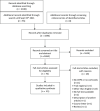Glucocorticoid treatment in patients with complex regional pain syndrome: A systematic review
- PMID: 35983980
- PMCID: PMC9826269
- DOI: 10.1002/ejp.2025
Glucocorticoid treatment in patients with complex regional pain syndrome: A systematic review
Abstract
Background and objective: The pathophysiology of complex regional pain syndrome (CRPS) is multifactorial, with an exaggerated inflammatory response being the most prominent. Treatment for CRPS is carried out according to the presenting pathophysiological mechanism. Anti-inflammatory treatment with glucocorticoids is therefore an option. The aim of this study was to systematically review the efficacy of glucocorticoids in CRPS.
Databases and data treatment: Embase, Medline, Web of Science and Google Scholar were systematically searched for articles focusing on glucocorticoid treatment and CRPS. Screening based on title and abstract was followed by full-text reading (including reference lists) to determine the final set of relevant articles. Bias was assessed using the revised Cochrane risk-of-bias-tool for randomized trials (Rob2).
Results: Forty-one studies were included, which reported on 1208 CRPS patients. A wide variety of glucocorticoid administration strategies were applied, with oral being the most frequently chosen. Additionally, researchers found great heterogeneity in outcome parameters, including clinical symptoms, pain relief and range of motion. The use of glucocorticoids caused an improvement of parameters in all but two studies. In particular, improvement in pain relief and range of motion were reported. Using glucocorticoids in CRPS of longer duration (i.e. more than 3 months) appears to be less effective.
Conclusion: Based on the present review, there is evidence to support glucocorticoid treatment in CRPS. However, the ideal administration route and dose remain unclear. We therefore recommend future research via an intervention study, as well as studies on the aetiological mechanisms and corresponding optimal treatment because CRPS pathogenesis is only partially understood.
Significance: Several studies point towards CRPS being an inflammatory response after tissue or nerve damage, with higher levels of pro-inflammatory cytokines in serum, plasma, cerebrospinal fluid and artificial skin blisters. Inflammation provides a possible role for glucocorticoids in treating CRPS. This systematic review provides a structured overview of glucocorticoid treatment in patients with CRPS. Improvement in pain and range of motion is shown. Systematic review registration number: PROSPERO-CRD42020144671.
© 2022 The Authors. European Journal of Pain published by John Wiley & Sons Ltd on behalf of European Pain Federation - EFIC ®.
Conflict of interest statement
None declared.
Figures
References
-
- Ali Taskaynatan, M. , Ozgul, A. , Kenan Tan, A. , Dincer, K. , & Alp Kalyon, T. (2004). Bier block with methylprednisolone and lidocaine in CRPS type I: A randomized, double‐blinded, placebo‐controlled study. Regional Anesthesia and Pain Medicine, 29(5), 408–412. 10.1016/j.rapm.2004.05.007 - DOI - PubMed
-
- Atalay, N. S. , Ercidogan, O. , Akkaya, N. , & Sahin, F. (2014). Prednisolone in complex regional pain syndrome. Pain Physician, 17(2), 179–185. - PubMed
Publication types
MeSH terms
Substances
LinkOut - more resources
Full Text Sources
Medical


